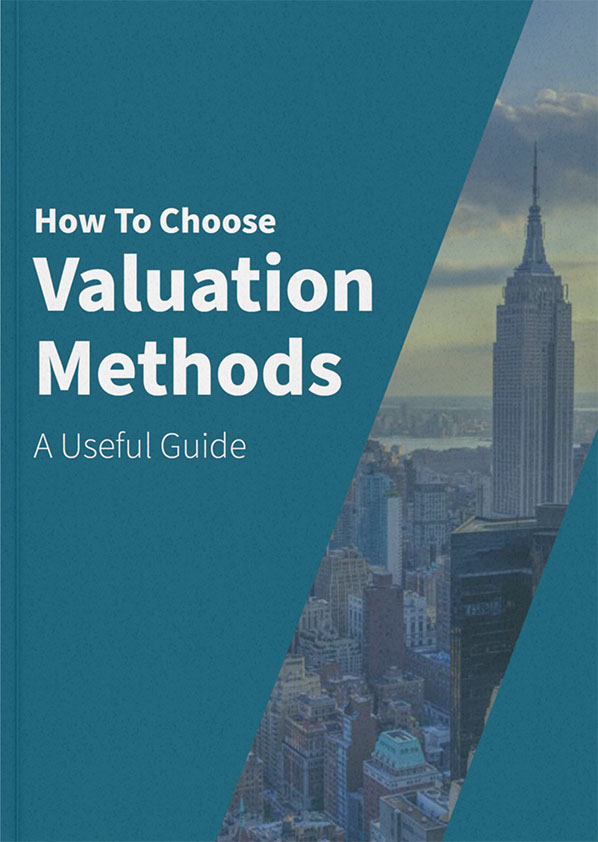Valuation Using Multiples – What Is It and How Does It Work? Core Ideas Explained

Valuing a business using ‘multiples’ is a common method for determining how much a business is worth. Below, we outline what this method is, the different ways it works as well as key considerations when using this approach to value a company.
What is valuation using multiples? Valuations using multiples is one of the three main approaches to valuing a business, sometimes referred to as the ‘market-based approach’. The method assumes that similar companies (or assets) should be valued similarly, so it uses financial data from other companies to help determine a company’s value. A financial ratio (or ‘multiple’) observed from these peer companies is applied to the company that is being valued. By applying this multiple from similar companies, the value of the new company is estimated. This is a simple and practical method widely used by valuation practitioners. The challenging aspect is finding the appropriate comparison company multiples to use.
First we provide a quick overview of key takeaway points, then we explain step-by-step how the method works.
QUICK OVERVIEW
- Valuation using multiples is one of the three main ways to value a business, sometimes referred to as the ‘market-based approach’
- It’s used widely by valuation practitioners, who will take a ratio either from comparable companies, or comparable transactions, to help value their target company
- It is often divided into two main approaches – Comparable Company Analysis (CCA) and Comparable Transaction Analysis (CTA)
- CCA compares using companies, whereas CTA uses transactions
- The ratio used might be EV/EBITDA, EV/Sales, P/E or another, depending on the valuation performed and the type of business being valued
- The ratio is then used in a simple multiplication calculation, to determine the value of the company in question
- The multiple being used is taken either from a company whose price is listed on a public exchange, or from an M&A transaction where the comparable company was the target of an acquisition
- These multiples/ratios can be time-consuming to find, and the selection of correct peer companies or appropriate transactions can have a large impact on the final valuation result
- Practitioners will often search online or subscribe to a database in order to access these multiples
- Valutico is one software platform where it’s possible to access these multiples (book a demo to learn more)
Major Assumptions of the Multiples Approach
This method assumes that one good way to value a company is to compare it with the value of similar companies. The major assumptions being that similar assets – or companies – will sell at similar prices, and that it is valid to make such a comparison between companies.
The method relies on using a financial metric known as a ‘multiple’ (a ratio), as a comparison point. So another major assumption when adopting this method, is that the type of ratio chosen as the comparison point, such as P/E or EV/EBITDA should be similar across similar firms.
Two Different Methods of Valuation Using Multiples
Broadly, there are two different common ways to value using multiples.
The first is comparable company analysis (CCA), also known as “comps”. The second is precedent transaction analysis, known as “precedents” and also called a comparable transaction analysis (CTA).
To conduct a comparable company analysis, a company is compared with its peers on the basis of these aforementioned multiples. The data for these multiples can be taken from publicly available sources as all of these measures can be calculated from the financial reports of the publicly traded companies.
On the other hand, it is more difficult to conduct a precedent transaction analysis as there is not much public data available for past transactions. However, to conduct such an analysis you have to search for transactions with similar businesses like the one you are analyzing. After that one can apply the above mentioned multiples to the target company.
Pros
- Can be used for a quick estimation of a company’s value
- Simple approach to value a company. Good to get a first impression
- When using the comparable company analysis, data can be easily derived from the annual reports of companies
- Easily defended as multiples are observed in the public domain
Cons
- Not all of the necessary data is publicly available when conducting a precedent transaction analysis
- Only applicable between companies of the same industry, which will sometimes make it hard to find the right peers and can therefore distort the result of the valuation
- Multiples are oriented to the past and can therefore only reflect the future with difficulty
- Comparing SMEs with large, publicly listed companies can be difficult and determining the correct discount to apply is very subjective
Comparable Company Analysis Formula
A valuation using multiples is based on the following simple calculation:
A financial (and in some cases even non-financial) metric is taken from the company that you are valuing.
This is shown in the center of the equation below. A multiple based on this metric, is taken from a set of other similar companies (far right). The original metric from the target company is multiplied by this multiple, to determine the value of the company.
That simple equation is how the value is determined.
In practice, however, this multiple (far right) might be the average (or median), taken from multiple similar companies in the industry.
Sometimes in very rough calculations it might just be the average for the industry. It’s rare that one would select one comparable company for this methodology, unless that company is identical in almost every respect.
Example:
Here’s an example of a particular metric you might use:
In order to determine the Enterprise Value of the business, you find the EBITDA from the business you’re valuing, and then multiply this by the EBITDA multiple observed from the other comparable companies. This EBITDA multiple is the EV/EBITDA ratio. From this we determine the Enterprise Value of the business.
The Underlying Logic of Valuation Using Multiples
The core way the approach works is to look at the financial performance of other similar companies, but not actually compare directly with say the main metric like sales, or EBITDA, but use the ‘ratio’ from those figures as the comparison point.
It is assumed that similar companies should be able to apply these ratios from one to another and return a valid valuation estimate, because they are similar enough in operations and business environment that it would be valid to do so.
Partly because this approach is simple and therefore practical, it is widely used by valuation practitioners. The challenging aspect is simply finding the correct comparison company multiples to use.
Choosing the Multiple
Multiples are taken from a range of different financial metrics, like EV/Sales or EV/EBITDA, and then applied to that related metric (e.g. Sales, or EBITDA) of the company you’re valuing by multiplication as shown above.
So, in the case of using EV/EBITDA, you would need to know the (median) EV/EBITDA multiple from similar companies, or the industry. In this simple example, you take that multiple (ratio) and then multiply it by your company’s EBITDA, to give you the EV or Enterprise Value.
Trading, Transaction and Experience Multiples
Broadly speaking, valuation multiples are used in two different methodologies as explained above, either in a trading comparable analysis (i.e. observed from companies listed on the stock exchange), or a transaction comparable analysis (i.e. observed from M&A deals). However, practitioners also sometimes make use of multiples known as ‘experience’ multiples. The differences between these three are expanded upon below.
Trading Multiples (a.k.a. ‘Comparable Company Analysis’, ‘CCA’, ‘Comps’)
- Comparable data is based on market prices of comparable, listed companies (a so called ‘peer group’)
- This valuation method reflects investor sentiment in sectors and markets
- Assumption: Share prices are an accurate reflection of fair market value
- Adjustments are often necessary (i.e. discount for lack of liquidity and/or marketability)
Transaction Multiples (a.k.a. ‘Comparable Transaction Analysis’, ‘CTA’, ‘Precedent Transaction Analysis’, ‘PTA’, ‘Precedents’)
- Comparable data is based on purchase prices in transactions with similar companies
- Strategic premiums, control premium, etc. are included in the transaction values
Experience Multiples
- Based on
- Industry estimates
- Surveys of market participants
- In practice, there is acceptance of such multiples in many industries
- Often used for very small businesses and early stage companies
- Examples:
- “Pharmacies are valued at 0.8x – 1.2x annual revenue“
- “Wind farms are valued at €0.8m – €1.2m per MW installed capacity“
- “SaaS start-ups are valued at 10x Sales”
Equity Vs. Enterprise Multiples – Which To Use?
The ratio is either related to the Equity Value or ratios related to the Enterprise Value.
An example of an equity multiple:
Price / Earnings
An example of an enterprise multiple:
EV/Sales, EV/EBITDA, EV/EBIT and practically all non-financial multiples (e.g. EV/ARR, EV/barrel, EV/MW, EV/Click, etc)
The decision as to whether to use an equity multiple or enterprise multiple is based on the metric we deem most appropriate, as well as the availability of data. The higher up in the P&L statement the metric is that is selected, the more assumptions are made on the similarity of operations of the respective companies.
For example, if we use the EV/Sales multiple (with Sales being the first item on the P&L), we disregard the operating (profit margins), capital (debt and interest) and asset structures (depreciation & amortization) of the companies. This is useful if we have limited information or are comfortable that the companies operate on a similar basis, but may become problematic if there are material differences in the way the companies operate.
On the other hand, if we use the P/E multiple (with Earnings being the last line item on the P&L), we have already taken the operating, capital and asset structures of the respective companies into consideration. We are thus comparing the prices per each unit of actual earnings.
Note that, because the impact of debt (in the form of interest), falls below EBIT on the P&L, typically any metric below that would be an equity metric and any metric above that would be an enterprise metric. This is because Enterprise Value consists of Debt + Equity but Equity Value only consists of Equity.
Common Types of Enterprise Valuation Multiples
Here are some common enterprise valuation multiples:
EV/Sales – This is the ratio of Enterprise Value to the sales of a company.
EV/EBITDA – Shows the ratio of Enterprise Value to the EBITDA of a company. It is often used as it eases the comparability between companies from the same industry (without having to worry about asset or capital structure).
EV/EBIT – Indicates the ratio of the Enterprise Value and the EBIT of a company. This is a very similar multiple to the EV/EBITDA excludes D&A (thus the asset structure).
EV/EBITDAR – The only difference between EBITDA and EBITDAR is that the latter also includes rental costs. Including this makes it easier to value companies which have nonrecurring or variable rent, like restaurants and casinos.
EV/Invested Capital – This multiple shows the proportion of Enterprise Value to the Invested Capital of a company. This expresses the Enterprise Value as a proportion of capital invested by debt and equity holders.
Common Types of Equity Valuation Multiples
Here are some common equity valuation multiples:
Price/Earnings (“P/E”): The price earnings ratio is the ratio of the price to the earnings of a company. It shows the amount an investor is willing to pay for one dollar of net earnings.
Price/Book: This multiple compares the price to the book value of a firm.
Dividend Yield (Dividend/Price): The dividend yield is used to compare the returns from owning shares (without taking share price appreciation or depreciation into account) with cash dividend returns.
Which Year to Use?
When the comparable companies approach is used, it is critically important to use the same P&L metric for the comparable company(ies) and the target company. For example, if I use the P/E multiple, I should use the Earnings of the comparable companies for the same year (say 2021) as for my target company.
Typically, one would initially use the last actual year as that is based on facts with no assumptions or estimates. One can, however, also conduct valuation exercises for several years for each multiple, i.e. using an EV/EBITDA approach for 2021, 2022 and 2023 (provided we have forecast EBITDA figures for our comparable companies and our target company).
Comparisons Are Often Using Companies in the Same Industry
Usually, it is very important to only compare companies from the same industry when conducting a valuation with multiples. The main reason is that trading multiples are different in various industries because of various factors that might be specific to an industry, such as market size, market growth, capital intensity, leverage, etc. It is therefore common to see industry-specific statements such as “US tech firms are trading at 20x earnings”, or “Construction companies are trading at 2x book value.”
Valuation with EBITDA multiples
Valuation with EBITDA multiples is often chosen because it disregards the effects of differences between companies’ debt costs (interest), taxes and depreciation & amortization on the valuation. As these are excluded from the valuation, the approach assumes that these comparable companies have similar operating characteristics (such as sales growth, margins and return metrics).







